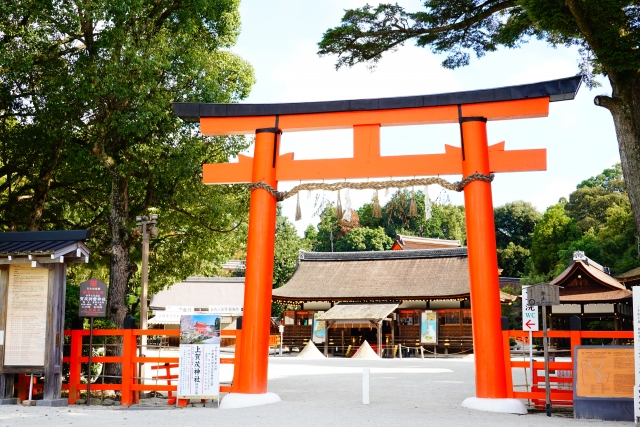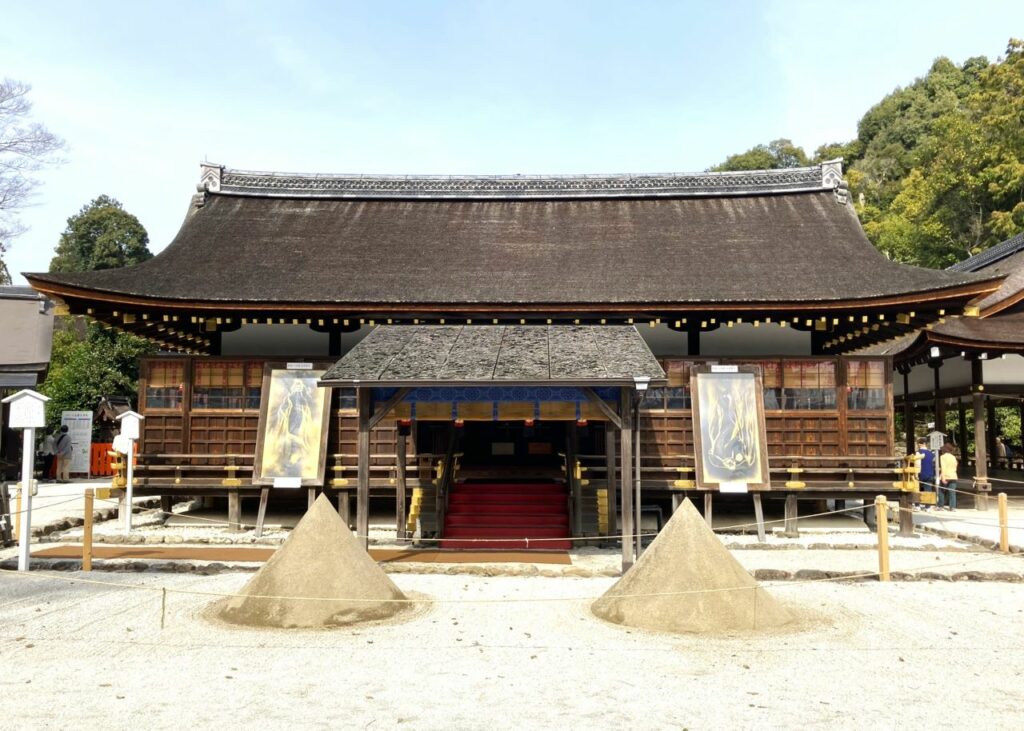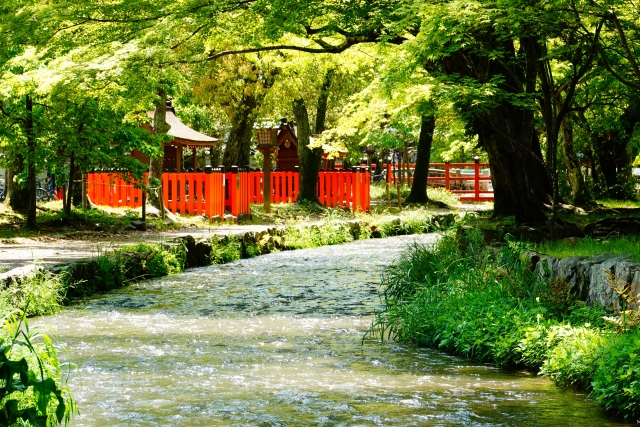Kamigamo Shrine is one of the oldest shrines in the ancient capital of Japan, Kyoto.
Together with Shimogamo Shrine, also in Kyoto, it is famous for the Aoi Matsuri (hollyhock festival), one of the three major festivals in Kyoto, and is a popular power spot that is worshipped by the locals.
In recent years, it has also become known as the "sacred" place for the animated movie Hello World, which is set in Kyoto, and more and more tourists from overseas are visiting the area.
In this article, we will introduce the history and instructions on how to worship at the popular Kyoto spot, Kamigamo Shrine.
- History of Kamigamo Shrine
- How to worship in Kamigamo Shrine
- Access to Kamigamo Shrine
- How to properly worship in Kamigamo Shrine
- First, visit the Hosodono, made famous by Hello World
- Visit the main shrine for a “special visit”
- Katayama Miko Shrine, a place where Murasaki Shikibu once visited
- Yatagarasu Mikuji, as seen in Hello World
- After visiting the shrine, take some time to relax in the garden or the café
- Let's enjoy the power of Kamigamo Shrine to the fullest!
History of Kamigamo Shrine

Kamigamo Shrine is officially called Kamo Wakeikazuchi Jinja Shrine, located north of Kyoto along the Kamo River.
The origin of the shrine is said to be that “Kamo Wakeikazuchi”, the deity of Kamigamo Shrine, descended from the mountain located north-northwest of the main shrine about 2,600 years ago. Kamo Jingu was built in 677, and the foundation of the shrine, which has remained almost unchanged to the present day, was laid.
The honden (main shrine) and the gonden (temporary shrine) are designated National Treasures, and the other 41 buildings are also Important Cultural Properties of Japan.
The entire grounds of the shrine, which cover an area of 230,000 m2, were registered as a UNESCO World Heritage Site in 1994, and the shrine is known as one of Kyoto's most venerable shrines.
Kamigamo Shrine is one of the oldest shrines in Kyoto and is believed to ward off bad luck and victory, and to be the patron god of the electrical industry.
It is one of the oldest shrines in Kyoto, and together with Shimogamo Shrine (Kamomio Shrine), is sometimes called “Kamo Shrine” because of its close connection to the Kamo Clan that once ruled this area.
How to worship in Kamigamo Shrine
Kamigamo Shrine is open to the public free of charge from 8 am to 5 pm, all year round.
However, between 10 am and 4 pm, it is possible to apply for a “special visit” that allows you to visit the national treasures, Honden and Gonden, in close proximity.
The “special visit” requires a 500 yen fee, but it is recommended to apply for this when visiting Kamigamo Shrine, as the national treasures Honden and Gonden are located in locations that cannot be seen during a normal visit to the shrine.
On weekdays, you can apply at the booth located just inside of the romon (red gate), which sells good luck charms, etc. On weekends and holidays, you can apply at the top of the stone steps just after passing through the romon (red gate).
Kamo Wakeikazuchi Jinja Shrine (Kamigamo Shrine)
Address: 339 Kamigamo Motoyama, Kita-ku, Kyoto City
Phone:075-781-0011(reception 8:30 am - 5 pm)
Honden and Gonden “special visit”: 10 am - 4 pm (until 4:15 pm on Saturdays, Sundays, and national holidays) / Fee: Adults: 500 yen (no charge for children under middle school)
Access: Short walk from “Kamigamo Jinja-mae” bus stop by Kyoto City Bus or Kyoto Bus
Subway Kitaoji or Kitayama station, approx. 10 min. by car
Ninotorii (second gate) opens: 5:30 am, closes: 5 pm
Official website:http://www.kamigamojinja.jp/en/
Access to Kamigamo Shrine
Access to Kamigamo Shrine is as follows.
It is not that far from JR Kyoto Station, about 30 minutes by car, so please use the subway or bus to get there.
From JR Kyoto Station, take city bus or Kyoto Bus to Kamigamo Jinja-mae bus stop. From Kitaoji or Kitayama Subway Station, approx. 10 min. by car
How to properly worship in Kamigamo Shrine
Let me show you the actual, proper procedure for worshipping Kamigamo Shrine.
First, visit the Hosodono, made famous by Hello World

Once you pass through the first torii gate at the entrance, you are in the sacred area.
A spacious lawn spreads out, and during the cherry blossom season, you can enjoy the Saio-zakura and Gosho-zakura cherry blossoms on the right.

In front of the second torii gate, there is a stable called Shinmesha (神馬舎 lit. "god horse stable").
On Sundays and national holidays (9:30 am to 3 pm), you can meet “Kamiyama-go,” a sacred horse used by the gods.
On those days, you can see special events such as carrot feeding, and the awarding of amulets and omikuji (fortune), which are only available here.

Beyond the second torii gate stands the “Hosodono,” which is designated as an important cultural property in Japan.
Hosodono was used as a place for the emperor and the Saio to dress for worship.

Hosodono was depicted as the setting in the anime film Hello World.
In front is the conical “tatezuna” (立砂 lit. "tall-sand" aka “morisuna=盛砂” lit. "mound-sand"), both of which appear in the film and whose beauty creates a mystical worldview.
If you have seen the movie, please take the time to visit the site while remembering the scene!

The tatezuna is in the shape of Koyama(神山 lit "god mountain"), the mountain where the deity Kamo Wakeikazuchi is said to have alighted.
Three pine needles stand on the left and two on the right, representing odd and even numbers, yang and yin.
The two are believed to be in harmony with each other, and to bring peace and harmony to the world.
Visit the main shrine for a “special visit”

Ahead of the aforementioned tatezuna is the tezumisha (手水舎 lit. "hand water place").
Before entering the main shrine, visitors wash their hands here to purify themselves.
The water from the Kamiyama spring is also drinkable.
A very nice human purification system.

Normally, visitors can only view the Honden at a distance through a bamboo screen, but if you apply for a “special visit,” you can enter the Honden and Gonden, as part of a guided tour (usually takes about 20 minutes).
This "special visit" is something that's easy to miss, so now that you know, you should apply for this.
After applying, you will be purified by a priest and then proceed to the Honden (main hall).
As you walk toward the Honden, you will gradually feel the atmosphere of a sanctuary.
The priest will explain the history and mythology of the shrine.
*Photography is not permitted during the special visit.
While listening to the explanation, you will notice a similar building next to the Honden on the left.
The Gonden is not usually used by the deities, but it is a temporary building to which the deities are moved when the shrine is being rebuilt or restored.
The Shingu Shrine, located beyond the Gonden, is dedicated to the Dragon God, who presides over water.
Since 2024 is the Year of the Dragon, don't miss the special opening of the gate on Saturdays, Sundays, and national holidays, where you can see a miko (shrine maiden) performing a dance!
Katayama Miko Shrine, a place where Murasaki Shikibu once visited
Katayama Miko Shrine, located near the gate, is the second most important of the 24 small shrines (regent shrines) within Kamigamo Shrine, after the main shrine.
It is especially popular among women, as it is believed to bring good luck in marriage, child bearing, and family peace.
Those who hope to receive such blessings should definitely visit Katayama Miko Shrine as well.

It is said that Murasaki Shikibu, the author of the famous Japanese classic “The Tale of Genji”, visited the shrine during the Heian period (794-1185), and there is a monument to a waka poem written by Murasaki Shikibu at the shrine.
It is a shrine with a long history.
Yatagarasu Mikuji, as seen in Hello World

Kamigamo Shrine is also known for its unique charms and omikuji.
Kamigamo Shrine is also known for its unique charms and fortunes, such as the “Kamo eggplant fortune,” which is associated with the birthplace of the Kamo eggplant, the “horse fortune,” which is associated with Kamo horse racing, and the “Yatagarasu fortune,” which appears in Hello World and is said to have led Emperor Jinmu to the shrine.
The image above is the “Yatagarasu-mikuji”, which is so cute that you can't help but want one!
When you visit the shrine, be sure to check out the amulets and omikuji as well.
After visiting the shrine, take some time to relax in the garden or the café

After visiting the shrine, stop by the garden “Shokeien” on your way home.
Shokeien was once the site of the “Kyokusui no En” (曲水の宴 lit. "bend-water party"), where aristocrats performed poetry and poems, and a reenactment of this event is still held every year on the second Sunday in April.

In addition, the entrance to the shrine will be renovated in 2023, a new Otorii gate will appear, a new shrine hall will be built, and a café inside the hall will serve lunch, etc., so relaxing at the café is also recommended.
Let's enjoy the power of Kamigamo Shrine to the fullest!
Kamigamo Shrine has a long history of approximately 2,600 years, and is a highly prestigious and sacred shrine.
Surprisingly, you can visit the Honden (main hall), a national treasure, at any time if you apply for a special visit.
Kamo Wakeikazuchi Jinja Shrine (Kamigamo Shrine)
Address: 339 Kamigamo Motoyama, Kita-ku, Kyoto City
Phone:075-781-0011(reception 8:30 am - 5 pm)
Honden and Gonden “special visit”: 10 am - 4 pm (until 4:15 pm on Saturdays, Sundays, and national holidays) / Fee: Adults: 500 yen (no charge for children under middle school)
Access: Short walk from “Kamigamo Jinja-mae” bus stop by Kyoto City Bus or Kyoto Bus
Subway Kitaoji or Kitayama station, approx. 10 min. by car
Ninotorii (second gate) opens: 5:30 am, closes: 5 pm
Official website:http://www.kamigamojinja.jp/en/
▼ Also available on YouTube! Please subscribe to our channel;) ▼
